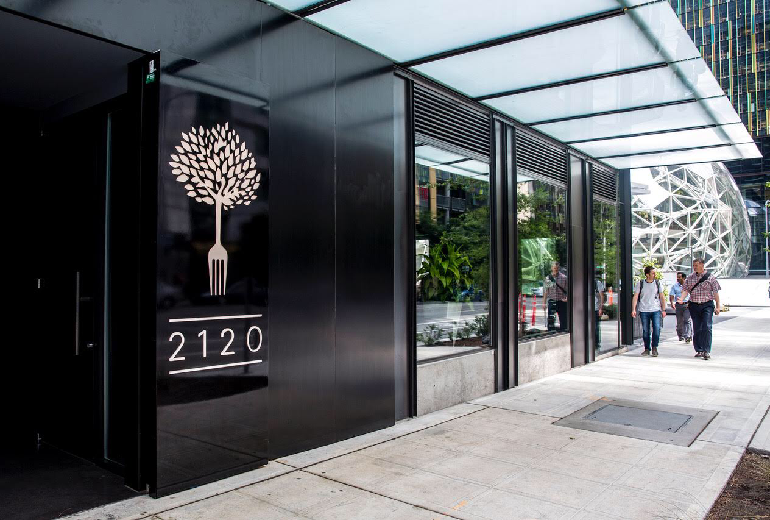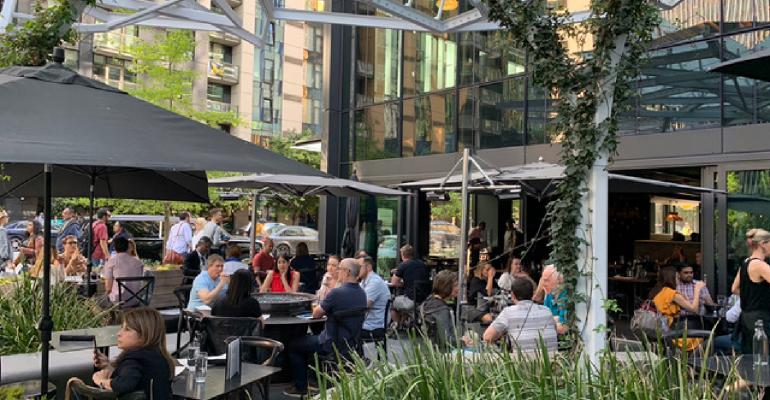For restaurant and bar operators, much of the past year can be boiled down to the axiom: “Just throw it against the wall, and see if it sticks.” Be it finding clever methods of pre-packaging cocktails, rethinking what types of food can travel to a guest’s home (and which can’t), discovering how to bootstrap your own delivery service, or reimagining the physical boundaries of your space, each new approach has yielded new learnings.
For many operators, this has meant doing something they’ve never done before: Establishing outdoor dining. Sidewalks, driveways and even parking lots have become second dining rooms, bringing a whole new set of lessons, frustrations and welcome surprises.
 “Our outdoor setup has been wildly successful,” said Christine Wright, general manager and wine director at Hearth restaurant in New York City. “At this point, with 50 percent indoor capacity and our 17 outdoor tables, we’re almost at 100 percent capacity. The most surprising thing to me was how many New Yorkers were willing to eat outside in sub-freezing temps.”
“Our outdoor setup has been wildly successful,” said Christine Wright, general manager and wine director at Hearth restaurant in New York City. “At this point, with 50 percent indoor capacity and our 17 outdoor tables, we’re almost at 100 percent capacity. The most surprising thing to me was how many New Yorkers were willing to eat outside in sub-freezing temps.”
For Wright and her team, there was much to learn on the service side. Tweaks were made to keep the staff moving efficiently, and for the restaurant to maintain a high level of guest satisfaction.
“All steps of service needed to be streamlined,” Wright said. “We began to pre-set silverware rollups and self-service water bottles on all the tables. This change alone bought the server an extra five minutes. And the menus for outside are shorter, which just allows everything to be executed easier. Cocktails are all batched pre-shift because we don’t want anyone waiting more than five minutes for their drinks. And all servers are also now trained to act as hosts, and most of them as bartenders as well. The more cross-training we’ve done, the more it allows every staff member to jump in and help in every capacity.”
In Seattle, Chris Elford, co-owner of four operations — Navy Strength, Vinnie's, Trade Winds Tavern and Here Today Brewery & Kitchen — also found great success with outdoor expansion. Two of his spaces now share an outdoor patio, and what began out of the early days of COVID will now continue mostly year-round. In addition to more seating, Elford has found that just the sight of outdoor diners has brought in new guests from the neighborhood who hadn’t previously known his venues were there. Think of it as a living, breathing billboard: that says “Come join us!”
While Elford offers the same menu on the patio as he does indoors, the staff began to use handheld point-of-sale devices when outdoors, which saves them precious time when taking guest orders. For him, the big changes have been on the infrastructure side of the equation.
 “We spent about $12,000 installing overhead heaters,” Elford said. “They are pretty effective, and while they aren't going to keep guests warm if it's freezing cold and windy outside, I estimate that they will increase our patio time each year by four to five months, which is huge.”
“We spent about $12,000 installing overhead heaters,” Elford said. “They are pretty effective, and while they aren't going to keep guests warm if it's freezing cold and windy outside, I estimate that they will increase our patio time each year by four to five months, which is huge.”
He recommended planning ahead when buying equipment for outdoor dining.
“I would just say, when you're shopping for heaters, outdoor tables, etc., do it at a time of year that others might not be. The lead times can be really long due to demand.”
In Clearwater, Fla., at Bascom’s Chop House, beverage director Kaitlyn Duke and team did a quick foray into outdoor dining with 10-12 tables, but have since dialed it back to only two tables, mostly reserved for those guests who prefer not to abide by the restaurant’s request to wear masks.
“Early on it was trial and error,” Duke said. “We quickly learned that the outdoor servers needed a lot of help from the support staff because they have to go inside for everything they need, so it was a lot of extra work.
 “The main challenge for beverage service was keeping white wine cold. We had to keep ice buckets handy and make sure they were filled with ice water, and not just ice [since ice water cools down the bottles faster]. For anyone in fine dining who may want to offer outdoor seating, think about how to streamline service, and definitely set up service stations out there. Also consider a uniform for your outdoor servers. If you are somewhere hot like Florida, it’s not practical to have servers in a vest and tie. Were we to continue doing this more than just temporarily, we’d want to invest in tents and air conditioning equipment.”
“The main challenge for beverage service was keeping white wine cold. We had to keep ice buckets handy and make sure they were filled with ice water, and not just ice [since ice water cools down the bottles faster]. For anyone in fine dining who may want to offer outdoor seating, think about how to streamline service, and definitely set up service stations out there. Also consider a uniform for your outdoor servers. If you are somewhere hot like Florida, it’s not practical to have servers in a vest and tie. Were we to continue doing this more than just temporarily, we’d want to invest in tents and air conditioning equipment.”
Chris Saenz, general manager and wine director at 2120 Restaurant in Seattle, also found that some significant infrastructure changes needed to be made once the summer weather of the Pacific Northwest faded. Having seen significant business from his initial foray into outdoor dining, and with many indoor dining restrictions still in place, he decided to push for a year-round solution -- a tent in the winter and the full patio in the summer.
With the tent, came a learning curve.
 “We worked with our landlord, and in December we installed a large 10-foot-by-50-foot tent on our patio space,” Saenz said. “This allowed us to place 10 tables with a [total] capacity of 20 guests in this space. We upgraded our electrical systems to accommodate a larger load and then installed several industrial floor fan-style heaters. In a short time, we found that this style of heater was great — until a gust of wind would clear the space of all the built-up warm air. We quickly made some adjustments and sourced several radiant style heaters, which we installed overhead. These provided a much better solution, as the direct heat cannot be dispersed by the elements.
“We worked with our landlord, and in December we installed a large 10-foot-by-50-foot tent on our patio space,” Saenz said. “This allowed us to place 10 tables with a [total] capacity of 20 guests in this space. We upgraded our electrical systems to accommodate a larger load and then installed several industrial floor fan-style heaters. In a short time, we found that this style of heater was great — until a gust of wind would clear the space of all the built-up warm air. We quickly made some adjustments and sourced several radiant style heaters, which we installed overhead. These provided a much better solution, as the direct heat cannot be dispersed by the elements.
“Rain was also a challenge, as our tent could not be fully sealed to our building,” Saenz said. “As a fix, we installed a gutter system so that there was not water coming down between the tent and the building.”
The outdoor patio has been a phenomenal success for 2120 Restaurant: Since January, they’ve been filling all their available reservations on the weekends, and most of them on weekdays. Saenz has also implemented the use of QR codes for guests to view menus, and has found that, while having an inviting space that protects guests from the elements is essential, it’s also important to ensure the staff is extending the same hospitality outdoors as they typically do indoors.

“The most interesting observation throughout this whole process has been how much guests want to interact with us,” Saenz said. “It seems like diners are using restaurants as a way to get their healthy dose of genuine human connection. So, make certain your practices are not so dry that they turn what could be a great experience into something that feels simply transactional. Remember, a quality dining experience and safely serving guests are not mutually exclusive. Effective training is key here, and having a team who can safely deliver these experiences is vital.”
Back at Hearth, Wright and the management team are looking ahead and building upon what they’ve put in place.
“It seems like this could be viable for a long time to come,” she said. “And outdoor diners are often choosing their restaurants based on how nice your setup is. So put some thought and creativity into it. If your outdoor space is beautiful and comfortable, you’ll more than make up for that initial investment in walk-in business alone.”
David Flaherty has more than 20 years of experience in the hospitality industry. He is a certified specialist of wine, a certified cicerone and a former operations manager and beer and spirits director for Hearth restaurant and the Terroir wine bars in New York City. He is currently marketing director for the Washington State Wine Commission and writes about wine, beer and spirits in his blog, Grapes and Grains.




